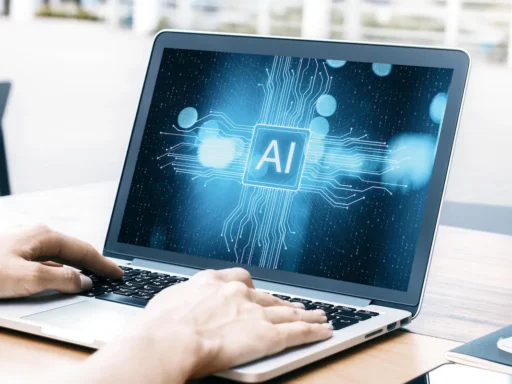Apple’s AI is Here to Make Eating Right and Staying Active Easier.
Here’s the thing—most of us are drowning in health data and getting zero clarity. One app counts your calories. Another tracks your steps. A third monitors your sleep (kind of). But all that data? It stays dumb. No context. No action plan.
Apple just fired a shot across the bow of half-baked health apps with its new AI project, blending the iPhone, Apple Watch, and Health app into something way more intelligent. It’s called Project Mulberry. And it aims to do what your gym trainer, your diet app, and your doctor don’t: stitch together a 360-degree view of your health and actually tell you what to do next.
They’re not just adding a “health tab” to your iPhone. This is machine learning tackling your lifestyle—an AI that watches how you lift, what you eat, and how long you sleep. Then it feeds back insights you can use.
Let’s break down how it works and why it might be the closest thing to a pocketable wellness coach we’ve seen yet.
Introduction To Apple’s Health AI Revolution
Try this: open your Health app. Now scroll through all the stats—blood oxygen, active energy, heart rate variability. How long did it take before you tapped out? Most people don’t even know what they’re looking at, let alone how to improve it.
That’s the friction Apple wants to erase.
Backed by over 1.2 billion active devices and a decade of building top-tier sensors, Apple’s health AI push isn’t just about collecting info—it’s about making sure your phone becomes the most proactive health partner you’ve ever had.
Project Mulberry is Apple’s upcoming AI coaching system that will power a new layer of health interaction across Apple Watch and iPhone. Rolled out under the likely name Health+, this subscription-based service will live inside iOS 19.4, landing in 2026.
So, what’s the real pain Apple’s trying to solve?
- Your health data is fragmented across too many apps.
- Each app gives you surface stats, not action steps.
- No one’s telling you what behavior needs adjusting—just rows of numbers.
Apple’s betting on deep AI integration—with privacy-first processing—to turn those scattered metrics into lifestyle strategy.
You don’t want 50 graphs. You want one clear answer: What do I do today to improve my wellness? Project Mulberry exists to answer that.
Project Overview: Enhancing Lives With AI-Driven Wellness Tools
Let’s start with the big picture.
Apple’s vision is simple but massive: build a true wellness assistant. Think of it as the Siri of your body.
It learns from your behaviors, watches how you move, logs what you eat, detects problems early—and then coaches you on what to do.
This isn’t a bolt-on to the Apple Watch. It’s an AI-native health stack across Apple devices—processing your biometric and lifestyle data on-device, then feeding it into personalized coaching systems.
Here’s how it works:
| Component | Purpose |
|---|---|
| Apple Watch | Gathers real-time metrics: heart rate, movement, oxygen levels |
| iPhone Camera | Scans meals for nutritional analysis and body movement during workouts |
| Health App | Central hub that syncs all data and user goals |
| AI Engine (Project Mulberry) | Analyzes trends, creates recommendations, flags anomalies |
The Vision: Smart Health Monitoring For Daily Life
Forget needing five different apps. Apple wants your wellness journey to start and end in one place.
And they’re going far beyond steps and sleep.
Their AI wellness assistant will blend:
– Food recognition through iPhone’s camera and LiDAR
– Habit tracking via watch and app inputs
– Sleep optimization using biometric baselines
– Workout enhancement using movement analysis
Why does this matter?
Because whether it’s back pain from crappy form or brain fog from poor sleep, your iPhone will finally know enough to tell you what’s off.
And with new cross-device syncing, that knowledge moves with you—whether you’re on a morning run or scanning your dinner.
Key Features And Functionalities
Food Logging & AI Nutrition Tracking
Let’s be honest—logging your meals one bite at a time is tedious. Apple fixes that by letting you scan your plate with your iPhone. The AI breaks it down: calories, proteins, fats, sugars. It even cross-checks ingredients based on your health profile (e.g., high blood pressure? It flags excess sodium).
Digital Coaching via AI Advisor
Apple’s AI won’t just say “you need 3,000 steps more.” It’ll tell you, “the past week’s data shows energy dips after low-carb breakfasts—try adding protein.” Weekly patterns, behavioral nudges, daily check-ins. All in context with your tracked health data.
Predictive Tracking That Flags Health Risks
That light snore and sudden dip in blood oxygen? The AI sees that as a trend—not a glitch. It learns your personal baselines and flags deviations that could mean sleep apnea, heart issues, or fatigue risk. Not just alerting you—but steering you toward early action.
This isn’t a fitness band loaning you a number. This is a co-pilot for living well.
How Apple’s Wearable Technology Transforms Daily Wellness
Think of the Apple Watch as your body’s black box, recording continuous data while you move, rest, and react to the world.
Through the sync loop with iOS Health, it captures:
– Heart rate variability
– Resting pulse trends
– Oxygen saturation changes
– Exercise intensity through motion tracking
But here’s what actually changes the game: real-time feedback that reprograms your habits, not just records them.
Going for a run? Your Watch analyzes form via iPhone camera, showing how to adjust your stride or squat for less knee strain. Doing yoga? Posture detection suggests stability work. And if you hit a certain threshold of activity, it automatically tunes your recovery recommendations.
It also works the other way around. Having a lazy day? Your wellness AI might recommend a hydration increase to offset sedentary blood pressure shifts. It doesn’t just tell you what happened—it suggests what to do about it.
Over time, the system learns your norms and builds a clear health story around your behavior. Then it applies that story toward specific goals—whether that’s reducing stress, building strength, or lowering your resting heart rate.
This isn’t another wellness gadget promising to “optimize your life.” Apple Health AI is about breaking data silos, getting you answers, and giving every heartbeat and bite meaning.
AI in Action: Personalized Insights for Modern Lifestyles
Ever tried logging every bite of food you eat? Most people quit after Day 3. Between spaghetti portions and late-night snacks, tracking nutrition can feel like a full-time job. Same goes for counting steps or making sense of your heart rate graph. That’s where Apple Health AI is framing a different future—one where your phone watches your habits like a coach, not a calculator.
Nutrition Tracking: Revolutionizing Food Logging
You open your iPhone, snap a photo of your breakfast bowl, and boom—calories counted, macros broken down, and notes on sodium flagged if your blood pressure has been spiking lately. That’s what Apple’s Health+ is going for under Project Mulberry. It uses a smart mix of camera tech, AI pattern recognition, and LiDAR sensors (yes, the ones used for depth in Face ID and AR) to measure volume and portion sizes that most apps only guess at.
Think food recognition like Snapchat meets your fitness coach. The goal is:
- Less guessing: Get accurate readouts of calories, protein, fats, carbs—with images, not typing.
- Smart alerts: If your trends show too much sugar or too little fiber, it lets you know before it hits your labs.
- Visual learning: Scans are connected to dietary databases and personalized suggestions rooted in your medical profile.
Let’s say you’re trying to cut sodium. You grab sushi, snap it first. The system flags high sodium fish, shows lower-sodium swaps in your area, and even links to a cardiologist-led explainer about sodium and blood pressure. This isn’t just food tracking. It’s preventive nutrition built into your daily camera roll.
Activity Monitoring: Automation for Smarter Movement
If your Apple Watch knows when you’re doing a brisk walk vs. dragging your feet to the subway, it’s because AI is paying attention. Apple Health AI blends sensor data from your watch and phone cameras to go beyond the basic “steps and sweat” metrics.
It doesn’t just tell you how much you moved. It tells you how well you moved. That squat at the gym? Your iPhone camera catches your form, uses machine learning to compare with thousands of correct postures, and gives real-time feedback: knees too far in, back too rounded. This isn’t just self-recording—it’s coaching on the fly.
Workout correction features toggle seamlessly between your Apple Watch data (heart rate, burned calories, effort zones) and on-screen form assessment for squats, yoga poses, or even running gait issues. For people with recurring injuries or just starting out, these insights aren’t just helpful—they’re preventative.
From pacing long runs to identifying muscle imbalances during lifts, Apple is trying to shut down the guesswork. It’s like having a personal trainer in your pocket—only one who’s silent unless you mess up your form.
AI-Driven Health Insights and Predictive Analytics
Ever felt tired even after 8 hours of sleep? Or wondered why your energy crashes a few hours after lunch? These invisible cracks in your health story are now being tracked, decoded, and patched using predictive AI. With all the sensor fusion Apple has built into its devices, Health AI is transitioning from passive data storage to real-time health guidance.
By cross-referencing your baseline biometrics—think typical sleep cycles, oxygen saturation, heart rate variability—Project Mulberry’s algorithms highlight patterns that don’t match your usual rhythms. They gently nudge you when something’s off—pointing out low hydration levels, inconsistent bedtimes, or even stress patterns based on heart data spikes.
One potent use? Early anomaly detection. A user frequently catching premature wake-ups with dipping oxygen readings may not notice the trend—but Health AI could flag potential sleep apnea weeks or even months before they’d seek help. The system doesn’t claim to diagnose, but it can urge you to get that checkup ahead of time.
In trials shared with academic partners like Stanford and Johns Hopkins, this predictive model has found signs of atrial fibrillation in patients with no external symptoms, prompting them to schedule early physician screenings and potentially dodging ER visits altogether.
What this means: your data stops being dust-covered metrics and starts being a map—one that alerts you when it sees you veering into trouble. Gone are the days when health problems had to scream. Now, Apple’s AI whispers before anything breaks.
Digital Coaching and Lifestyle Optimization
Most people know what they should be doing: eat less processed food, move more, sleep better. But “getting your act together” isn’t a feature on your calendar app. Apple’s Health AI tries to tackle this not by overwhelming you with data—but by transforming your habits quietly, day by day.
Enter the AI lifestyle advisor baked into Health+. It doesn’t lecture. It learns. It picks up how often you skip breakfast, when your energy dips, and how many times you snooze your wind-down alert. Then it adapts the coaching to fit your actual schedule, not an idealized fitness influencer’s day.
For someone struggling with late-night eating, Health AI might delay dinner reminders, show evidence-backed video tips from dietitians, and track whether earlier meals equal more restful sleep. It mixes passive data collection with active nudges—insights from professionals, but based on your personal reality.
This coaching goes beyond one-off tips. It builds a personalized rhythm:
- Automated habit builders like water reminders, stand goals, or bedtime routines
- Behavior recommendations cross-referenced with clinical guidelines and trained medical advice
- Progress reports with visual breakdowns showing impact over time—not just guilt-triggering stats
It’s not a replacement for your doctor. But it can keep your doctor from seeing you only when something breaks. Apple’s Health AI doesn’t just want you to move more—it wants you to move smarter. And sleep deeper. And maybe, finally, understand why that 2 p.m. crash hits so hard.
Apple’s Competitive Edge in AI-Driven Health Innovation
People are fed up with disconnected health trackers and apps that promise results but deliver friction. So what makes Apple’s new play — the Apple Health AI system under Project Mulberry — not just another tech flex?
Let’s break it down. Apple isn’t building a calorie app or a smartwatch gimmick. It’s dropping a data-driven health layer across your day — and doing it in classic Apple style: closed loop, cleaned up, and locked in.
Privacy? Nailed. Apple’s been loud about processing health data directly on devices. Zero cloud uploads unless you approve. With biometric info this personal — sleep quality, heart irregularities, even food analysis — that’s major.
Then there’s flow. Everything plays nice, tight, and real-time. Your iPhone camera scans your dinner and matches that with Apple Watch biometrics. Eat lasagna → AI logs it → Watch checks your glucose trend → AI suggests your next workout. All without hopping between nine apps.
- On-device AI processing: Health data stays private, minimizing 3rd-party exposure.
- Tight integration: Watch, iPhone, Health app — all speaking the same language.
- Sensor synergy: LiDAR + biometrics + camera for precise, contextual tracking.
Now, look sideways at the competition. MyFitnessPal? Great logbook, but patchy with actual coaching. Google Health Connect? More of a backend plumbing tool. Noom? Psychology-based tips, but nowhere near Apple’s hardware advantage.
Here’s Apple’s trump card: over a billion active devices. You’re already in their ecosystem. They’re not building on rented land — they own the whole street. That lets them roll out updates like Health+, with pro videos, smarter alerts, and predictive scans, without asking users to switch apps or habits.
Say you’re tracking sodium for high blood pressure. With Apple Health AI, the scan isn’t just counting — it cross-references your ECG spikes and flags a risk, offering swaps and workouts built on actual data, not trends.
Everyone else? Still figuring out how to talk between sensor and suggestion. Apple’s already walking you through the response.
Ethical Considerations of AI in Health Management
Here’s the part that matters just as much as the tech: Trust. We’re talking about algorithms shaping your sleep, workouts, even diet. If the data flows wrong, or the model’s assumptions are off, real harm happens.
Apple’s bet is on ethics as infrastructure. Their AI models run locally, and training data goes heavy on partnerships with clinicians, not just data miners. According to published interviews and FOIA-derived physician advisory documents, the system pulls buckets of anonymized input from Stanford and Johns Hopkins — not random Reddit logs or user-fed data swamps.
Still, there’s skepticism. Algorithms deciding how often you should sleep or how much sodium to cut sounds safe — until it nudges users toward patterns that don’t work for their unique physiology.
That’s why every recommendation logs its source. You’ll know what’s driving those alerts. Apple’s team claims a white-box approach, where even personal health suggestions can be reverse-traced to the model weightings or physiological thresholds that triggered them.
That’s not status quo. Most health apps push content based on dumb behavioral averages. Apple pushes content built around your vitals, your trends, your anomalies. And to counter bias? They’re not winging it. The AI is continuously trained on balanced case reviews from cardiologists, nutritionists, and psych advisors — not only out of Cupertino, but hospital floors across the U.S.
Now, take that compared to Noom or MyFitnessPal, whose models rely mostly on standard user archetypes and goal self-reporting. High variance, low accountability. Apple’s system checks your nightly heart rate dips, not your last meal selfie.
In short — their north star isn’t just profit from engagement but proactive, personalized, and diagnostically relevant guidance. But they’ll need discipline to keep it there.
Vision for the Future: Redefining Personalized Health Automation
Let’s talk direction. Where does this go next? Apple’s not playing small-ball with step counts and reminders. They’re aiming for predictive baseline deviation flags — that nudge you before your symptoms arrive.
What if your Watch noticed subtle shifts in blood oxygen, movement instability, or disrupted REM cycles — and linked those to risk factors like early respiratory illness or burnout syndrome?
That’s where Mulberry’s headed. Not just an assistant but a sentinel.
And wearables? Apple’s setting them up as scouts — not just fitness tools. Think personalized stress alerts during high-pressure meetings, or AI-generated recovery plans tailored to your monthly health rhythms, all adjusted without you clicking a single thing.
They’re trying to automate healthy living the way Tesla tries to automate driving — invisible help, but there when it counts.
This isn’t a gadget race. It’s behavior fusion — tech that molds to you, not forces you to adapt to it. If they pull it off, Apple Health AI won’t just answer health questions…it’ll rewrite the real-time playbook we live by.





